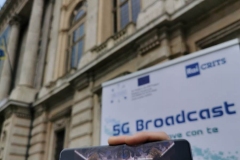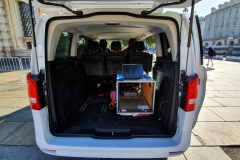The Rai Center for Research, Technological Innovation and Experimentation (CRITS), in cooperation with its international partners, is carrying out research and experimental activities on 5G, the new mobile technology introducing important features in order to make it a useful complement to the traditional broadcast technologies, being them either terrestrial or via satellite, especially for the content and TV service delivery towards mobile devices.
The activities aim to promote a new approach where the new mobile technologies can be implemented by using the traditional broadcast networks, the same that are currently used for DTT, in order to operate in a cooperative way with cellular networks; they are configured to fulfill specific service requirements, such as the free TV offer, a wide coverage and an efficient TV distribution, both in terms of spectral resources and costs optimization for the customers and the operators.
In the context of the UC4 “High quality video service distribution” of 5G-TOURS, Rai worked on a 5G broadcast solution to deliver video contents to massive audiences through its High-Power High-Tower (HPHT) infrastructure. After almost one year of laboratory activities in which preliminary tests were performed for both transmitter and receiver stations, the 9th of November the on-field trial has been finally performed. During the concert “The Garden of Forking Paths” by the composer Andrea Molino (see the related news here), Rai successfully tested the transmission of a high quality video stream towards mobile devices in 5G broadcast mode according the most recent implementation of the 3GPP enTV Rel-16 standard. In particular, thanks to the experimental transmission using 5G broadcast technology from the Rai Way transmitting site of Torino Eremo, the concert has been made available on mobile devices provided to the people visiting a demonstration area located in Piazza Castello, where an ad-hoc receiving chain was installed on board of a Rai special VAN. The demonstration showcased the potential of 5G for the TV reception in terms of video and audio quality enhancements as it will be on the next generation mobile phones and tablets implementing this technology.
Thanks to its high speed, low latency and the possibility to operate in both interactive and broadcast mode, in the next future the 5G technology will be able to transmit very high quality contents during huge audience events, also opening new perspectives for the distribution of immersive 360° video, augmented reality and interactivity on the customers side.
Relevant links:
5G-TOURS deliverable: D4.2 “First Touristic City use case results” (section 5), D3.3 “Technologies, architecture and deployment advanced progress” (section 5.4)





